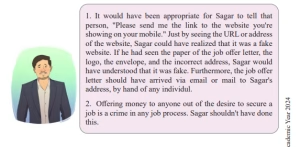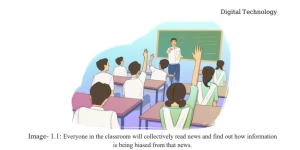Preparation for the Digital Future
Our daily lives are constantly changing due to the advancement of technology. Lifestyle, transactions, communication, professions, and entertainment mediums are all evolving. It’s impossible to predict the changes that will occur in our lives five years from now. Therefore, we must be prepared to embrace any changes in this ever-changing world. Our education and knowledge are not limited to textbooks; we need to gather information from the internet and other sources to expand our knowledge. For this reason, the ability to effectively exchange accurate information is an important skill.
We will create a bulletin in our school by verifying the validity of information through this experience. Additionally, we will create an online portfolio for ourselves, where we will regularly upload everything we have accomplished throughout the year, including various tasks and projects related to digital technology and other subjects. This will allow anyone, from any part of the world, to see and learn about the research and projects we have undertaken in a year.
Now, let us begin our journey of creating the school bulletin!
Session 1: Search for Truth of Digital Future
With easy access to the internet, we can search for any information within moments. However, this convenience has also allowed bad actors to spread false information, causing confusion. When creating our school bulletin, each of us must find at least one accurate piece of data to contrast with the published incorrect information and write an essay or article about it.
To do this task, we need to understand how misinformation can be propagated. By reading the following incidents, we will identify how false information spreads.
Scenario 2 : Sagar’s Job Scam
Sagar, after completing his studies, applied for jobs at several banks and was preparing for interviews. One day, while reading a book on interview preparation on a bus, a person sitting next to him struck up a conversation. The person claimed that his elder brother worked at a prominent bank and offered to help Sagar get a job if he paid some money. Sagar agreed and handed over the money.
A week later, the person gave Sagar a job offer letter from the bank and even showed him a website where employed candidates’ application numbers were listed. Sagar found his number on the list and, satisfied, gave the person more money. However, when he went to the bank on the specified date, he found out that the job offer letter was fake.
Let us think for a moment, how did the crook on the bus manage to present a believable fake offer letter and website?
Ans of these Question
The crook on the bus was able to present a believable fake offer letter and website by carefully crafting his deception. He likely forged the job offer letter to closely resemble an official document from the bank, making it look genuine and professional. The website he showed to Sagar was either a completely fake one designed to imitate a legitimate site or a real website with manipulated information, such as fake application numbers.
This added an extra layer of authenticity, convincing Sagar that the job offer was real. The crook also built trust through personal interaction, claiming to have insider connections, which made Sagar more comfortable and less suspicious of the offer. By delivering the fake job offer letter quickly and exploiting Sagar’s eagerness to secure a job, the crook created a sense of urgency that pushed Sagar to act without verifying the authenticity of the documents. This combination of forgery, manipulation, and personal trust made the scam highly convincing.
Scenario 2: Jyoti’s Laptop Scam
Jyoti was a ninth-grade student. One day, when she returned home from school, her mother told her that the government would provide laptops to all students of grades nine and ten. Her mother had seen a news report on YouTube explaining the application process. Jyoti watched the news and recognized it as a reputable television channel from Bangladesh.
Without doubt, she filled out the application form, including her personal information, and emailed it. The next day, someone called Jyoti’s mother, claiming that they needed to send money through mobile banking to cover courier charges, after which they would receive the laptop. Jyoti’s mother sent the money. Later, they realized that the mobile number was blocked, and Jyoti discovered they had been victims of a scam.
Let us think for a moment, how did the crook manipulate the YouTube news report?
Answer of this Question
Scenario 3: Palash’s Fake Textbook News
Palash’s father received an image in his social media inbox from a friend. The photo seemed to be from a nationally recognized magazine, with the magazine’s logo visible. The image showed an inappropriate picture in a ninth-grade textbook. Palash’s father was naturally upset, as Palash was in the ninth grade. He shared the message from his social media account, and many of his acquaintances shared it as well. A week later, at a parent-teacher meeting, Palash’s father brought up the issue with the headteacher. The principal explained that the news was false and manipulated.
Let us think for a moment, how was that newspaper news manipulated or faked?
Answer of This Question
The newspaper news was manipulated or faked by using an image that appeared to be from a legitimate, nationally recognized magazine, complete with the magazine’s logo and card. This gave the impression that the information was credible and had been officially published. The image contained a false message about an inappropriate picture in a ninth-grade textbook, which naturally caused concern for Palash’s father, especially because his son was in that grade.
The fake news likely used photo-editing tools to alter or create the textbook page shown in the image, making it appear as though the offensive content was real. By spreading this manipulated image through social media, the crook relied on the trust people place in established publications and the tendency to share information quickly online without verifying its accuracy. Palash’s father, like many others, assumed the information was true because of the recognizable logo and format, leading to widespread sharing of the false news before anyone realized it had been distorted or faked.
In the three scenarios mentioned, what could Sagar, Jyoti and her mother, and Palash’s father have done to avoid falling victim to these scams?



Answer of the question
In these three scenarios, Sagar, Jyoti and her mother, and Palash’s father could have taken several precautions to avoid falling victim to these scams.
Sagar could have verified the legitimacy of the job offer by directly contacting the bank or checking official job portals instead of trusting the person on the bus. He should have been cautious about anyone asking for money in exchange for securing a job, as reputable organizations do not typically request payment for employment. Additionally, Sagar could have examined the offer letter carefully for inconsistencies or sought advice from trusted sources before proceeding.
Jyoti and her mother could have avoided the scam by confirming the news report through official government websites or contacting school authorities. Although the YouTube video appeared to be from a reputable source, cross-verifying such information with legitimate government channels would have helped them avoid providing personal information and sending money to strangers. Before transferring money, they could have asked for more proof and checked whether there were any official government schemes regarding the laptops.
Palash’s father, upon receiving the image about the inappropriate textbook content, could have fact-checked the claim by looking at his son’s textbooks or consulting with the school directly before spreading the message. He should have been more skeptical of the social media post, especially if it came without credible sources. By doing so, he would have avoided contributing to the spread of false information and could have helped others steer clear of the fake news.
In each case, the key lesson is to be skeptical of unsolicited offers or shocking claims, to verify information from trusted and official sources, and to avoid sharing personal or financial information without proper verification.
In these three situations, we have discovered different methods by which information gets distorted. There are several organizations in Bangladesh that analyze such misleading information and help to uncover the truth.
If we search on search engines (Google, Bing, Yahoo) using the keywords ‘Fact Check Bangladesh,’ we will find the names of some websites that verify or fact-check false information.
As a class, we will read several verified news articles from any two of these websites. Afterward, each student will explain one by one how the news articles had been distorted or manipulated.
Unit 2: Lesson 1 What is a dream?
Unit Three: Lifestyle Lesson 4: Fitness
Lesson 1: The Storm and Stress of Adolescence
Lesson 2: Adolescence and Some (Related) Problems in Bangladesh
